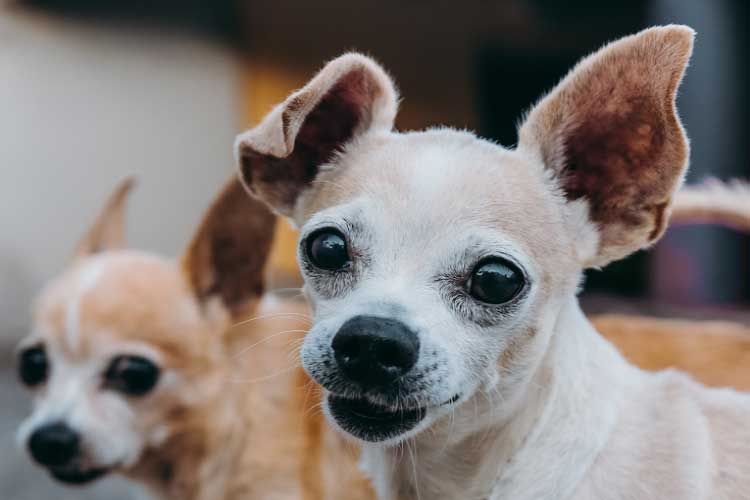I was wondering why your Chihuahua has floppy ears.
Good news: Here you’ll find out the truth.

Quickly read further to discover:
- Two tips about floppy-eared Chihuahuas.
- Nine surprising reasons why your Chihuahua has floppy ears.
- What’ Domestic Syndrome’ is (and why this might be why your Chihuahua has floppy ears).
- And more…
Here’s an engaging animated video about this theory:
Why do Chihuahuas have floppy ears?
All Chihuahuas have floppy ears when they’re young. However, some continue to have them into adulthood, which could be due to genetics, diet, or stress. Additionally, some Chihuahuas may not be fully Chihuahua, and other Chihuahuas have a predisposition towards floppy ears.
I’ll explain nine reasons some Chihuahuas have floppy ears in detail. I’ll also give you tips for dealing with floppy-eared Chihuahuas.
Here’s why your Chihuahua has floppy ears.
Nine indisputable reasons why Chihuahuas have floppy ears
#1: They’re still young
Chihuahuas are usually born with floppy ears. This may be surprising to anyone who’s seen a full-grown Chihuahua.
You may be wondering why they are born with floppy ears. It’s simple, and a Chihuahua puppy’s ear cartilage needs time to develop.
Additionally, the muscles at the base of their ears aren’t strong enough. Just like the rest of their body, their ears take a while to grow fully into a mature form.
They’re still adorable with floppy ears, especially as puppies. But now, you may wonder how long it will take them to look like ‘real’ Chihuahuas.
In most cases, their ears usually stand within five weeks, which can take up to 6 months.
If they retain floppy ears after six months, there could be other reasons. Some of these reasons may be genetic, dietary, or stress-related. Before we get into these possibilities, let’s discuss another developmental reason.
#2: They’re still teething

When Chihuahuas begin to lose their baby teeth, their ears sometimes droop, which is directly related to the muscles associated with teething.
It may seem strange, but it’s typical for young Chihuahuas.
Chihuahuas cut their baby teeth in their first year (usually between 4 and 6 months old). They like to chew during this period—a lot.
It can be worrisome when they’re gnawing for an extensive time. But they’re just preparing themselves for their adult teeth, which also comforts them to chew when their teeth come out.
Some breeders note that Chihuahua ears lose their perkiness while they’re teething. Their ears are perfectly upright before and after teething, and they become floppy during teething, though.
This is because their jaw muscles become tired after working for a long time. The jaw muscles are connected with the ear muscles, and when the jaw muscles lose strength from teething, so do the ear muscles.
#3: They’re not fully Chihuahua
If your Chihuahua still has floppy ears after six months, they might not be purely or entirely Chihuahua. There are a lot of Chihuahua hybrids (mixed breeds or cross-breeds).
Some popular Chihuahua hybrids are Chipugs or Chips.
Chipugs are Chihuahua and Pug hybrids, and Pugs have floppy ears sometimes. When a Pug and Chihuahua are cross-bred, they might have floppy-eared kin.
As I’ll further explain, genetics is a significant determinant of ear perkiness. Chihuahuas as a breed generally have perky, upright ears. They must possess this trait for dog competitions, per the American Kennel Club AKC).
If you want to follow the AKC guidelines, finding a reputable breeder is essential. A good breeder will ensure that their Chihuahuas are purebred, and they also look after their litter and only breed Chihuahuas with upright ears.
If you want a good house pet, it’s not as essential to get a Chihuahua with perfect Chihuahua ears. Other reasons for buying a purebred Chihuahua may help you get your money’s worth altogether.
One of the reasons to buy purebreds is the comfort of knowing that your Chihuahua puppy has been looked after. In some isolated cases, it is said that hybrids, sadly, may not have received the level of care that purebreds require and usually get.
Another possible reason one would opt to buy a Chihuahua with upright ears is the medical or health consideration of having a decreased chance of infection. Chihuahuas with floppy ears are twice as likely to get an ear infection.
But this is no cause for alarm or worry, though. We can do things to prevent infections, and I will list some later in this article.
#4: They’re genetically predisposed towards floppy ears
Some Chihuahuas with floppy ears may be hybrids. However, some purebred Chihuahuas also grow up to have floppy ears.
Just like any other genetic trait, ear floppiness is a trait that has a lot of variabilities. It doesn’t mean that they’re a different species, and they probably just come from a line of floppy-eared Chihuahuas.
Most breeders try to breed Chihuahuas to have upright ears.
Some breeders don’t care as much about ear floppiness. Sometimes it can be hard to control what a dog will look like.
Even with parents with perfectly perky ears, a Chihuahua pup can turn out with floppy ears…
A floppy-eared pup from perky-eared parents doesn’t indicate unhealthiness.
Some mutations can have negative implications for dogs. For example, Pugs with shorter noses can have breathing problems. But a Chihuahua with floppy ears can be just as healthy as one with perky ears.
As previously stated, the only adverse health consequence is the possibility of an ear infection. Floppy-eared Chihuahuas are also unable to participate in AKC competitions.
But why do dogs have floppy ears in the first place? That is the more interesting question. As it turns out, many evolutionary and biological factors exist, and the hypothesis that sums up these factors is “Domestic Syndrome.”
#5: They have “Domestic Syndrome.”
Some dogs have floppy ears because of “Domestic Syndrome.” It’s not dangerous, and it is theorized that it is what happens when wild animals become tame.
Although the name sounds like a horrible disease, it’s an interesting hypothesis.
This theory attempts to explain why tame animals have floppy ears. Interestingly, it applies to a lot of animals, not only dogs.
The famous biologist Charles Darwin first contributed to this theory.
He noticed wild animals usually have upright ears, while tame animals generally have floppy ears. The only wild mammal with floppy ears is the elephant.
Darwin was able to make the connection between tameness and floppiness. But he was unable to explain why the link exists…
Later, Russian scientist Dmitry Belyaev created an experiment to test the theory. He selectively bred wild foxes for tameness. Once the foxes became tame, they did become floppy-eared as well.
Amazingly, this experiment continued for more than fifty years. Lyudmilla Trust, Belyaev’s successor, also tried experimenting on rats and minks.
Trust’s team suggested a genetic regulatory network responsible for all the traits found in domestic animals. This attempted to explain other characteristics of tame animals like shorter noses, smaller teeth, paler fur, and floppy ears.
However, in 2014, Adam Wilkins and his team came up with their hypothesis. They found Trut’s hypothesis inconsistent with other genetic regulatory networks and instead proposed the importance of neural crest cells in Domestic Syndrome.
#6: They have fewer neural crest cells
Neural crest cells regulate the fight or flight response.
When wolves were trying to survive in the wild, it was vital for them to have these cells. Later on, wolves living near populated areas could rely on leftover scraps from humans.
When humans fed them, it was instead essential for them not to be fearful or angry. Less scary and angry wolves got more food, and wolves became tamer and tamer as they evolved toward these traits.
Eventually, the wolves who relied on human companionship started to look and act like today’s dogs. They had short snouts, small teeth, splotchy fur, and those floppy ears we all love.
What does this have to do with neural crest cells?
Neural crest cells (NCCs) are linked to all traits indicating “tameness.”
NCCs determine the amount of cartilage in the outer ear. Animals with lower adrenaline have a lower amount of neural crest cells.
All this means is that floppy ears are byproducts of the long process of domesticating dogs. Dogs with upright ears might still have the NCCs that produce ear cartilage.
As a result, floppy-eared Chihuahuas may seem tamer or friendlier. Domestic Syndrome is still a hypothesis but represents over a century of research.
We’re much closer to solving the “floppy ears question” than we were in Darwin’s day.
#7: Their adrenaline levels are low (or high)
Chihuahuas with floppy ears have fewer NCCs, which means they also might have lower adrenaline levels.
Is this good or bad? It’s hard to say. They may be less prone to stress. But some breeders have noticed that high-stress environments lead to floppy ears too.
Midwest Chihuahua says that one of their Chihuahuas went through a tough pregnancy. Her ears were upright before. But after the high stress, her ears became floppy.
In his article, Wilkins notes that droopy ears can also be seen in humans with Mowat-Wilson Syndrome. This syndrome is also typified by low brain function and a happy/smiling disposition.
Interestingly, dogs usually possess this disposition, as well. An alert dog will perk up their ears, and at the same time, a relaxed dog will droop their ears.
If your Chihuahua’s ears are floppier or more upright than usual, their adrenaline levels may have changed. Check to see if something is bothering them. Are they happy? Sad? Stressed? Relaxed?
Some Chihuahuas can even change their ears from day to day. One day they may have floppy ears; on another, they can have upright ears. Or, in some cases, one ear is up, and another is down.
This perky one day, floppy the next can also happen during teething. It’s certainly cute, if not a little confusing.
#8: Their diet is unhealthy
It can be hard to feed a Chihuahua sometimes.
But nutrition is essential for their:
- Skin.
- Joints.
- Cartilage.
Diet may have the ability to promote or prevent upright ears.
If your Chihuahua’s food doesn’t have enough nutrients, your dog won’t grow the way it should. This is another reason you want to be sure to buy from a breeder who raises healthy pups.
When bringing your Chihuahua home, ensure you have good dog food. There are lots of reliable brands.
You’ll also want to make sure to buy dog food from a country or a part of the world with high-quality control standards such as:
- The U.S.
- Canada.
- Australia.
- New Zealand.
- And Western Europe.
Make sure that a protein is listed as one of the first ingredients. Dog food shouldn’t have too many refined grains, and too much corn or rice can lead to inflammation.
There are some other things to look for too.
Try to find food brands with fatty acids like Omega-3 and Omega-6. These are found in oily fish. Avoid dog foods with added artificial coloring or flavoring.
A Chihuahua’s diet should be low in quantity and high in quality. The average Chihuahua only needs 200 calories per day. But all of those calories should be from top-quality sources.
So you should probably prioritize feeding over snacking. Doing this will ensure their ears will stay perky. Or, if they’re floppy-eared, they’ll stay healthy, happy, and floppy.
#9: They were bred to have floppy ears
I don’t mean to sound like floppy ears are a problem, and they aren’t. Dogs may have floppy ears because some humans prefer floppy-eared dogs.
More specifically, many people prefer floppy-eared Chihuahuas to Chihuahuas with upright ears.
With that in mind, sometimes, breeders selectively breed dogs with floppy ears.
Many breeders choose to breed for instead of against floppy ears. It’s easy to see why. Floppy ears are simply adorable.
The American Kennel Club can be a little too prescriptive anyway.
This is what they have to say about how Chihuahua ears should be:
‘Large, erect type ears, held more upright when alert, but flaring to the sides at a 45-degree angle when in repose, giving breadth between the ears.
This might be what the Taco Bell Chihuahua looked like, but your dog can look however it wants. The most important thing for breeders is making sure their dogs are healthy.
As previously stated, floppy ears are no cause for concern. If they are to you, it’s better to discuss your concerns with the breeder before you buy rather than after.
If floppy ears seem atypical for your dog, look into their diet and stress levels.
Two tips about floppy-eared Chihuahuas
You already know why your Chihuahua has floppy ears. Now what? Here are two essential tips for your floppy-eared friend.
What should I do if I have a floppy-eared Chihuahua?
#1: Avoid taping / cropping their ears
Many articles online or videos suggest taping or cropping Chihuahua’s floppy ears to “fix” them.
Cropping is a procedure where part of the outer ear flap is cut. This makes the outer ear stand upright. Some people do this to make their dog’s ears look more upright.
The fact is, there’s no way to “fix” a Chihuahua’s floppy ears. There isn’t anything to fix, and that’s how they’re supposed to be.
Cropping or taping their ears hurts the dog. The best way to ensure perky ears is to find a breeder who will meet your expectations. Some breeders specifically select perky ears when breeding.
Ear cropping is illegal in the U.K. and some other countries. In the U.S., though, ear cropping is legal for some breeds.
It’s important to understand that the downsides of ear cropping far outweigh its potential benefits…
The only reason cropping happens is for breeding standards and cosmetic purposes.
The downside is much worse, though. It’s an unnecessary surgical procedure, first of all. Why would you want to put your dog through stress and pain if you don’t have to?
Another thing to consider is that complications can arise with any surgery, and there could be continued bleeding, infection, or increased sensitivity and pain.
In the worst cases, their ears have to be amputated.
If cropping is out, what about taping? Taping may seem fine, and it’s undoubtedly safer than cropping. Yet it also causes your dog pain, and their ear muscles can get sore from standing at attention for too long.
People pick dogs for their cuteness, of course. But there is only so much you can do after you select your dog. Your dog is happiest when it’s the way it’s supposed to be.
#2: Take care of their ears

Chihuahua ears aren’t more sensitive than other dogs’ ears. But they’re prone to infection, and Chihuahuas with floppy ears are twice as likely to get ear infections.
The best way to prevent this is to check your Chihuahua’s ears. It would help if you cleaned off any dirt or wax and the ear’s exterior, and it would help if you never went into their ears.
The best way to clean their ears is with a wet cotton swab. You could also ask your vet for a bottle of cleaning solution.
You should also check for symptoms of ear infections.
One sign of an ear infection is if your Chihuahua keeps shaking their head…
Another sign is constant scratching at one or both ears.
Floppy ears are more prone to infection. This is because of all the folds in a floppy ear, and bacteria or mites can live in them if they’re not cleaned.
Dirt, hair, or other objects can get stuck in their ears, which is valid for both floppy and upright ears.
Dog owners can often be forgetful of ear health. But it’s just as important as any other aspect of their dog’s health. Chihuahuas have their ears for more than cuteness.
Chihuahua ears are, of course, necessary for their hearing. But they can also indicate their mood or their health. Be sure to go to a veterinarian if their ears look abnormal or if they can’t hear as well as before.




